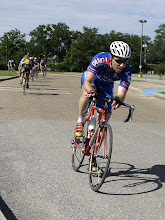To Continue....Objective Findings
Defining research models for cycling is a difficult squirrel to catch. There are so many things going on within the cycling activity and so many variables that most research models fall short. Don't get me wrong, this is not the fault of the researcher. In the scientific approach, you have to constrain the or limit certain variables so that the finite piece of information you are evaluating can be captured with the least amount of extraneous interference. Well, in doing so, you create something that is not real. The more you constrain the activity, the less the activity resembles cycling.
My mentor in the sport defines the problem as this: "We have bodies in motion, in motion". ???
The human body is in motion, moving legs, arms and head. The bike is moving: wheels are turning, crank, chain and fork/handlebar. And...the entire complex is moving down the road. Combine all of this and it's an incredible amount of data to control. Add the fact that the rider is responding to other people on bikes(in a peleton) or cars(in traffic). There's no way to get your hands around the situation in one simple research project.
On the positive side, there is a tremendous amount of research about the human body that defines how we move, where we are strong, how we learn etc. There is also a great deal of information in the area of mechanics(physics). It seems to me that the cycling community expects research about cycling to somehow include a bike in the project. However, should we just discard years of research about how the human body operates? Does the body somehow do something magically different once we are on the bike? I think not. The body is bound by physiologic principles that have been defined. You can read about them in any high school or collegiate Exercise Physiology text.
Here's where a few people are using common sense. There are a few that are not blown around by every new breeze in the cycling research. We don't search for pots of gold at the end of the rainbow. We do things the "old fashion way(with new technology to help)". We apply the principles of human physiology to the sport of cycling. We consider all aspects of the sport and all possible experiences that the cyclist may encounter. We communicate this in a straight forward manner and we get results.
I'm sorry for the long winded nature of this entry. I'm on a roll.
Back to objective findings. Here's how it works. The pedal stroke can be defined based on muscle physiology. I can evaluate this in a matter of seconds to let you know where you are loosing power. After showing this to you in a video format, I can walk you through the negative impact of poor technique and show you the benefits of good technique. You will be able to feel the difference.
Lasting change is up to you. You have to take the information gathered during the session and incorporate it into you daily training plan. If you do, you will notice the difference.


0 Comments:
Post a Comment
<< Home